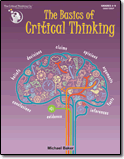We love Logic at our house. One of the skills, besides a love for God and His Word, we long to develop in our kids, is the skill of critical and logical thinking.
Just recently I was able to appeal to what he was learning in clarifying an argument that he was having with his brother, and where he did not get the logic his dad was applying to the situation. Once I worked him through the process, using some concepts he had learn in Basics of Critical Thinking, it made sense to him and we were able to move forward.
The book is colourful and easy to use. It is a workbook that can be worked on independently since everything is explained and demonstrated, and the answers are located at the back of the book. As a parent all you have to do is keep an eye on what your child is learning so that you keep up and help him practice what he is learning in everyday life.
One of the last products we got to review for the crew was one of those. It comes from a very well known company especially committed to developing curriculum in this subject for homeschoolers: The Critical Thinking Co. They have been around for a while and keep coming up with new products on a consistent basis. I was very delighted to receive one of those for review: The Basics of Critical Thinking.
The Basics of Critical Thinking is a book designed to teach kids the process of evaluating argument starting from the very basics of what an argument, a fact, an evidence is, and building up from that. It is designed for grades 4-9, and having looked through the book and my 5th grader work his way through it, I can say that the grade range is about right.
I had been wanting to do some sort of logic curriculum with my 5th grader and this came at the right time. I had him work on this 4 times a week (the duration of our school week), going though about a chapter a week (depending on the length of the chapter). The way the chapters are set up is as follow: a concept is introduced and explained, then it is demonstrated and then, followed by a set of practice exercises that will help the student to learn to apply it or recognize it.
The concepts covered are as follow:
• What Is Critical Thinking?
• Conclusions and Decisions
• Beliefs and Claims
• Finding (Identifying) Evidence
• Evaluating Evidence
• Inferring and Inferences
• Facts and Opinions
• Facts and Probable Truths
• False and Probably False
• Facts, Probably True, and Probably False
• Venn Diagrams
• Logical Connectives
• Advertising
• Agreements and Contracts
• Common Errors in Reasoning
• Arguments
• Valid and Invalid Arguments
• Fallacies
• Analogy Argument
I chose my 5th grader to review this with because, being a logical, Mathy kind of child I figured it would be good for him to learn formal logic and have anchors to base his thinking upon. He tends to be like me sometimes and come up with his own logic. Having gone through the first few chapters I can say that it is helping.The concepts covered are as follow:
• What Is Critical Thinking?
• Conclusions and Decisions
• Beliefs and Claims
• Finding (Identifying) Evidence
• Evaluating Evidence
• Inferring and Inferences
• Facts and Opinions
• Facts and Probable Truths
• False and Probably False
• Facts, Probably True, and Probably False
• Venn Diagrams
• Logical Connectives
• Advertising
• Agreements and Contracts
• Common Errors in Reasoning
• Arguments
• Valid and Invalid Arguments
• Fallacies
• Analogy Argument
Just recently I was able to appeal to what he was learning in clarifying an argument that he was having with his brother, and where he did not get the logic his dad was applying to the situation. Once I worked him through the process, using some concepts he had learn in Basics of Critical Thinking, it made sense to him and we were able to move forward.
The book is colourful and easy to use. It is a workbook that can be worked on independently since everything is explained and demonstrated, and the answers are located at the back of the book. As a parent all you have to do is keep an eye on what your child is learning so that you keep up and help him practice what he is learning in everyday life.





Comments